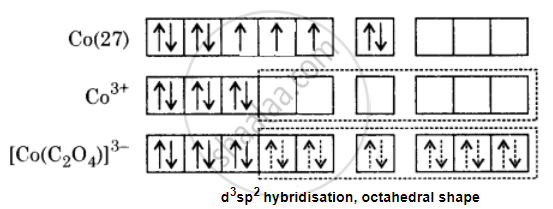Advertisements
Advertisements
प्रश्न
Discuss the nature of bonding in the following coordination entity on the basis of valence bond theory:
[Co(C2O4)3]3−
उत्तर
Electronic configuration of Co (Z = 27) = [Ar] 3d74s2
Electronic configuration of Co3+ = [Ar] 3d64s0
\[\ce{C2O^{2-}_4}\] is a strong field ligand due to which electrons are paired.

Hence, it is clear that [Co(C2O4)3]3− is a diamagnetic and octahedral complex.
APPEARS IN
संबंधित प्रश्न
On the basis of valence bond theory explain the nature of bonding in [CoF6]3 ion.
Explain on the basis of valence bond theory that [Ni(CN)4]2− ion with square planar structure is diamagnetic and the [NiCl4]2− ion with tetrahedral geometry is paramagnetic.
Predict the number of unpaired electrons in the square planar [Pt(CN)4]2− ion.
Discuss the nature of bonding in the following coordination entity on the basis of valence bond theory:
[Fe(CN)6]4−
Discuss the nature of bonding in the following coordination entity on the basis of valence bond theory:
[FeF6]3−
[NiCl4]2- is paramagnetic while [Ni(CO)4] is diamagnetic though both are tetrahedral. Why? (Atomic no. Ni = 28)
Using valence bond theory, explain the following in relation to the complexes given below:
\[\ce{[FeCl6]^{4-}}\]
(i) Type of hybridisation.
(ii) Inner or outer orbital complex.
(iii) Magnetic behaviour.
(iv) Spin only magnetic moment value.
If orbital quantum number (l) has values 0, 1, 2 and 3, deduce the corresponding value of principal quantum number, n.
How many radial nodes for 3p orbital?
Which of the statement given below is incorrect about H2O2?
When the hybridization state of carbon changes from sp3 to sp2 and finally to sp, the angle between hybridized orbital will
As the s-character of hybridised orbital increases, the bond angle
Which of the following has square planar structures?
In Fe(CO)5, the Fe – C bond possesses
Using Valence bond theory, explain the following in relation to the paramagnetic complex [Mn(CN)6]3-
- type of hybridization
- magnetic moment value
- type of complex – inner, outer orbital complex
Using valence bond theory, predict the hybridization and magnetic character of the following:
[CoF6]3– [Atomic number of Co = 27]
Write the hybridisation and magnetic behaviour of [CoF6]3−.
[Given: Atomic number of Co = 27]
The magnetic moment of [NiCl4]2− is ______.
[Atomic number: Ni = 28]
[Ni(CO)4] has tetrahedral geometry while [Ni(CN)4]2− has square planar, yet both exhibit diamagnetism. Explain.
[Atomic number: Ni = 28]
During chemistry class, a teacher wrote \[\ce{[Ni(CN)4]^2-}\] as a coordination complex ion on the board. The students were asked to find out the magnetic behaviour and shape of the complex. Pari, a student, wrote the answer paramagnetic and tetrahedral whereas another student Suhail wrote diamagnetic and square planer.
Evaluate Pari’s and Suhail’s responses.
